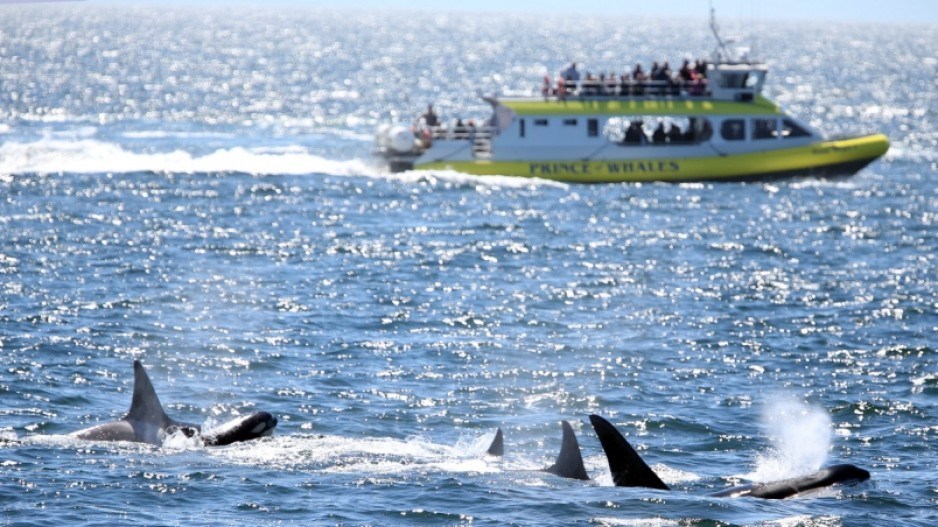When B.C. scientists went looking for proof that a lack chinook salmon was behind a decline in the southern resident killer whale population compared to their northern cousins, they found some of their assumptions about chinook abundance and killer whales might be backwards.
If southern resident killer whales (SRKW) aren't getting enough to eat in the Juan de Fuca in the summertime, it's not due to a lack of chinook, a study published in Canadian Science Publishing suggests.
Mei Sato and Andrew Trites of the University of BC’s Marine Mammal Research Unit, and Stephane Gauthier, a researcher from the Department of Fisheries and Oceans, based their study on surveys of chinook densities in the summer habitat of the SRKW (Juan de Fuca Strait) and northern resident killer whale (Johnstone Strait).
Because chinook is the primary diet of both populations of killer whales, and because the NRKW are thriving (numbering around 300), while their southern cousins are in decline (down to 75), they assumed they would find the SRKW simply didn’t have as much access to chinook as their northern cousins.
What they found, however, was that the density of chinook was four to six times higher in the SRKW’s summer range of Juan de Fuca Strait than in NRKW summer habitat of Johnstone Strait.
“These findings do not support the hypothesis that southern resident killer whales are experiencing a prey shortage in the Salish Sea during summer and suggest a combination of other factors is affecting overall foraging success,” the study concludes.
The NRKW ranges from Alaska to B.C., while the SRKW’s range is from southern B.C. to California. Chinook make up 86% to 100% of both populations’ diets during summer months.
“Northern and southern resident killer whales have a strong mutual reliance on chinook salmon, but do not appear to have been equally affected by range-wide declines of chinook salmon,” the study finds.
The scientists used ship-based sampling and echosounders to determine chinook abundance, size, and spatial distributions in the Johnstone Strait and Juan de Fuca Strait in the summers of 2018 and 2019.
“Contrary to our hypothesis, prey densities were higher in the southern resident killer whale habitat than in the northern resident killer whale habitat,” they write. “This difference in prey density between the two habitats may reflect higher numbers of chinook salmon using Juan de Fuca Strait instead of Johnstone Strait as a corridor to return to their natal rivers in the Salish Sea.
“Our finding that densities of Chinook were 4–6 times higher in southern resident habitat than in northern resident habitat is at odds with the few sightings of southern resident killer whales in the Salish Sea in 2018 and 2019.
“Our data suggest that their low frequency of summer occurrence was not due to an absence of prey in the Salish Sea.”
If southern resident killer whales aren’t getting enough to eat when they are in local waters, it appears not to be because of a lack of food. But the higher concentration of boat traffic in the Juan de Fuca Strait may be a factor in limiting their ability to feed.
“The physical presence of vessels and the noise they create are two factors that could impede the ability of killer whales to successfully forage,” the study notes. “Background noise levels increase with nearby vessel counts and may mask communication between pod members and interfere with foraging and navigation.”
“Furthermore, physical presence of vessels reduces foraging effort of resident killer whales. Such interference occurs more frequently in the southern than northern resident killer whale habitats, and could theoretically impact foraging abilities and survival rates.”
Over the last two summers, increased restrictions on recreational fishing – including new no-fishing zones in killer whale foraging areas – have been implemented by DFO to address declines of both chinook and the SRKW.
Owen Bird, executive director of the Sport Fishing Institute of BC, hopes DFO considers the study’s findings in any future management of recreational fisheries.
“Often the remark was made that southern resident killer whales were starving and they didn’t have enough chinook,” Bird said. “This study definitely helps to refute or debunk that myth.
“We hope this study will encourage DFO to reflect on the measures that they’ve implemented and adjust accordingly.”




